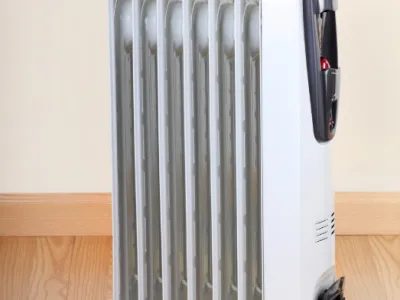Using space heaters efficiently and safely

Published January 6, 2022
We’re officially in the thick of the heating season, and with that comes the temptation to stay warm at any cost. The urge to use space heaters is strong, especially on those days below zero, but they can come with a heavy cost. Here are some tips to manage usage and safety measures to keep in mind.
Space heaters can be helpful and sometimes necessary to boost the temperature of a room that does not have adequate heat or to create extra warmth for someone who is especially sensitive to colder temperatures, such as a baby or an elderly family member.
Though space heaters can be effective in heating smaller spaces, electric costs can quickly add up. A typical space heater’s power ranges between 750-1500 watts, meaning that using a single space heater for 8 hours a day could cost around $20-$45 in a month.
Thermostat-controlled space heaters, which allow you to set the unit to your desired room temperature, are less likely to waste energy because they can automatically stop heating when the room reaches the desired temperature. These can cost less to operate, but they still consume a large amount of energy.
If you use a space heater, it is important to pay attention to the heater’s safety directions to prevent any fire hazards or risk of burn. Place the heater on a flat and stable surface at least three feet away from any potentially combustible materials (e.g. curtains, papers, clothes, or furniture), water, or flammable liquids. Plug space heaters directly into the wall socket, rather than using extension cords or power strips, and make sure that there are no signs of fraying or other damage to the cord. Lastly, use a space heater when you are in the space, and then turn it off when you leave the room or are sleeping.
There are also many alternative ways to stay warm at home and minimize your heating bills. When dressing in layers is not enough, an electric blanket can be a less costly option. Electric blankets’ power demand varies but is often around 60 watts — just 4-8 percent of what a space heater uses. Another way to feel more comfortable is to seal leaks where cold air can enter your home and warm air can escape. For example, use plastic window wrap to seal up drafty windows and weatherstrip doors, or use draft blockers on leaky windows and doors. To get a full picture of where your home may be leaking energy, consider getting an energy assessment (also called an energy audit). Many utilities offer discounted energy audits, and income-qualified households can receive these services for free through the federal weatherization program or utility programs.
For more winter energy-saving tips, check out this blog post.
As always, if you are struggling to pay your utility bills or are just looking for ways to save energy in your home, contact us at 651-300-4701 ext 2 or info@cubminnesota.org to learn about energy assistance programs or to schedule a free 30-minute bill consultation.